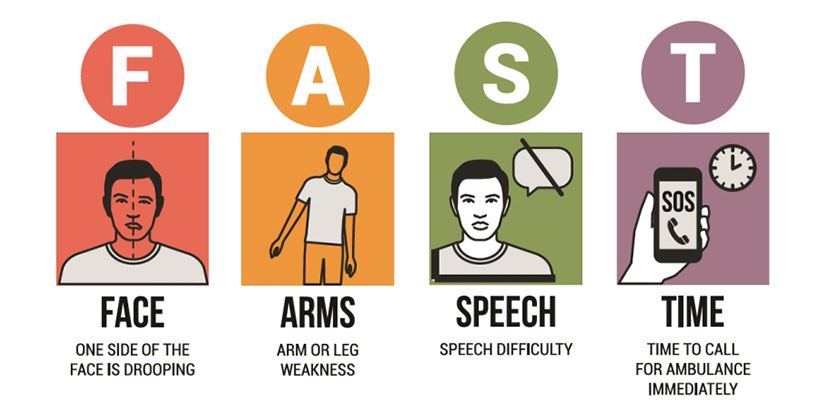Stroke 101
- Category: Brain Health, Healthy Living, Heart Health
- Posted On:

Do you know the warning signs of stroke? Learn to recognize the signs of a stroke and call 911 immediately if you—or someone with you—exhibits any of these signs.
Remember: minutes count when you are having a stroke.
When you have a stroke, a part of your brain is deprived of oxygen-rich blood and within minutes, brain cells begin to die. This causes symptoms in the part of the body controlled by the brain area affected. Strokes can cause permanent brain damage and disability and are the fifth leading cause of death in the U.S. There are two main types of strokes.
Ischemic (Is-KE-Mik) Stroke
Nearly 90% of strokes are ischemic strokes.
Ischemic strokes occur when a clot, caused by atherosclerosis (the buildup of plaque in your arteries), blocks a blood vessel, cutting off the supply of blood. A clot can form directly in a blood vessel that supplies blood to the brain (cerebral thrombosis), or it can form in an artery elsewhere in the body. If the clot breaks lose, it can get stuck in a small blood vessel in the brain. This is called a cerebral embolism. Many ischemic strokes are caused by clots that form in the carotid arteries, the main arteries on either side of your neck.
A Transient Ischemic Attack or mini-stroke (TIA) is also caused by a clot-related blockage. However, a TIA is temporary. The clot either dissolves on its own or nearby blood vessels reroute blood around the clot. TIAs usually don’t cause long-term brain damage, but they are a warning sign that you are at risk for a stroke.
Hemorrhagic (Hem-A-Raj-Ik) Stroke
The other 10% of strokes are caused when a weakened blood vessel in the brain ruptures. The blood accumulates and puts pressure directly on brain tissue or in the space between your brain and your skull.
The first line of a treatment for a stroke is to dissolve the clot or to find and control bleeding in the brain.
Of course, it’s best to prevent strokes in the first place. One way to do this is by managing your blood pressure. More than three-quarters of first-time stroke patients have blood pressure that is higher than 140/90 mm Hg. A 10 mm Hg drop in the top number, or a 5 mm Hg drop in the bottom number, can cut your stroke risk in half, according to the American Stroke Association. Eating well, exercising, and controlling your blood sugar and cholesterol will all help lower your risk of stroke.

.jpg)

